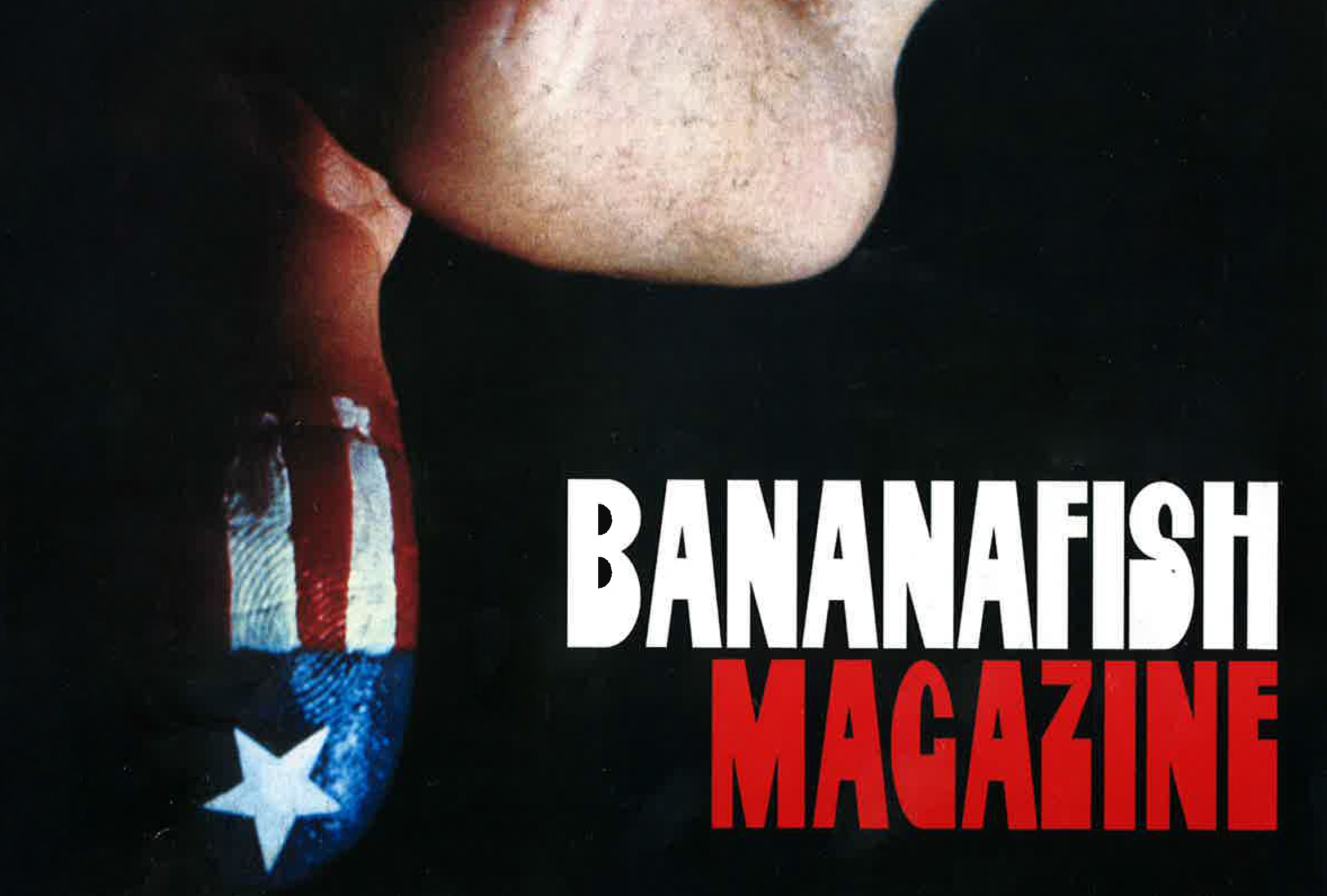Bananafish Magazine: Stranger Than Fiction
The curious history of San Francisco’s influential and idiosyncratic noise zine
The final issue of the Bananafish magazine began with an obituary of its longtime publisher, I. Vern Beezer. His deliriously funny letters opened every edition since 1990, and as the publication’s only consistent column it served as the staff’s opportunity to construct a rather convoluted narrative of its own development. The last introduction provided some explanation of Bananafish’s demise and a clearly embellished account of Beezer’s death credited to his niece, who reports that her 91-year-old uncle died of congestive heart failure in mid-sentence while “hollering something hilarious and mean” at a TV broadcast of a presidential debate for the 2004 election. Beezer’s apparent passing was the fatal blow to the prolific noise-oriented zine, which garnered an enduring cult following for its coverage of avant-garde music and art over 18 issues starting in 1987 and ending in 2004.
“I think we were ready to be done anyway,” the Bananafish founder known as Seymour Glass told me over the phone. (It had taken some careful maneuvering to reach the magazine’s anonymous, enigmatic mastermind and then to get him on the line.) He admitted that the details of Beezer’s life and final moments as reported in Issue #18 were “poetic license” but declined to disclose the truth. As for Bananafish, he explained that the publication had suffered “one indignity after another” in the years leading up to its dissolution – decreased sales, a decline in willing advertisers, fewer promotional offerings from record labels – which made it harder to justify the expenses involved in maintaining its existence.
“It’s expensive, it’s time consuming, it takes a lot of energy – and I was getting ready to have a kid,” Glass recounted from his office in San Francisco. During the vetting process before our interview, Glass sent a timeline of Bananafish’s history that was ostensibly compiled by a fan who did interviews with important staffers, and which reports that the eighth edition was the first to make it into “mom’n’pop record stores all across America and is the first issue of the magazine most people had ever seen.” But by 2004 fewer retailers were interested. “It was so many little things that when [Beezer died] it was like, ‘Okay, let’s just end this,’” Glass said.
Beezer’s posthumous finale put the long-running zine to rest with comedic and outlandish anecdotes typical of the publication, this time in the form of journal entries documenting the daily disgraces of waiting for death at a retirement home called Voir Destinir, likely a fictional location because there’s no evidence of its existence. Likewise, the residents he describes seem too obnoxious to be real, such as a sanctimoniously spiritual woman with hypocritically massive breast implants and a retired surfer who brags incessantly about defecating in line at the DMV and inspiring the children’s book All About Scabs.
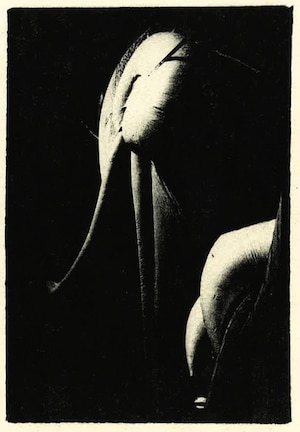
As per the usual structure of Bananafish, Issue #18 also contained a schizophrenic letters section featuring found (and probably fabricated) fragments from the likes of unidentified spurned lovers or recruiters for cosmic church cults. That’s followed by interviews by and with experimental artists – in this case, drone violinist C. Spencer Yeh of Burning Star Core and Argentinian composer and Reynols band member Anla Courtis, among others. The last section is unconventional, conversational reviews of little-known records, and a rundown of some of the most famous artists included give some indication of the range of tastes and overall obscurity of the selections: Suckdog frontman and performance artist Jean-Louis Costes’ Hung By The Dick CD; Wolf Eyes’ collaborations with likeminded American noise outfits Black Dice and Smegma; a release from Polish avant-garde composer Zbigniew Karkowski; works by free or experimental jazz instrumentalists like Axel Dörner and Peter Brötzmann.
Bananafish also came with a compilation CD starring its subjects, a musical offering that began when RRRecords offered to press a 7" for Issue #4 in 1989. In many cases, those recordings provided fans one of the only means to hear the bands they read about, a lot of which is still hard to find even with the advent of digital music. Bananafish was and is a rare source of exhaustive information about the international noise and avant-garde-related underground, from those who remain off the grid to artists who achieved various levels of acclaim, like Sonic Youth’s Lee Ranaldo, Japanese harsh noise outfit Merzbow, Romanian spectralist composer Iancu Dumitrescu and freak-psych cult heroes like Caroliner and Alan Bishop of Sun City Girls.
Over the years, Bananafish’s compelling taste in obscure music, art and performance, as well as the amusingly irreverent tone and content, elevated it from a well-produced amateur fanzine to a renowned scene figure in its own right. Some of its subjects, like Dylan Nyoukis of Prick Decay and Bruce Russell of the Dead C, became contributors, and others were avid readers. Wolf Eyes’ John Olson, who appeared in Issue #13 in 1999, wrote via email that he had followed it from beginning to end, and Australian drone guitarist Oren Ambarchi sought out every issue after he first found it in a Sydney record shop in the late 1980s.
“It was a very important resource for me, being in Australia without much ‘literature’ on the noise underground – and it was hoot,” recalled Ambarchi, who was interviewed in Issue #16 in 2002. “It shaped what I did as a young musician, as I would search for releases of the artists that Bananafish covered,” he said, describing a search for Bananafish’s hardly-known subjects. “I would pore over it to find more clues about this mysterious underground music/culture.”

The musicians who provided their artist or given names in bylines or features seem to be some of the only Bananafish contributors to openly identify themselves in its pages. So many writers used aliases that it’s nigh impossible to gauge the size of the staff at any point in its history, let alone which names are real and which are fake. Seymour Glass pinched his own pen name and the title of the magazine itself from a short story by J.D. Salinger, “A Perfect Day For A Bananafish,” in which a disturbed war veteran struggles to communicate his troubles and experiences to other adults in polite society, and his inability to assimilate makes him suicidal. The only person who seems to understand him is a little girl named Sybil, who partakes in his fantasy of seeing a made-up breed of doomed creatures called Bananafish swimming in the water of a beach resort right before the Glass character returns to the room he shares with his oblivious girlfriend and shoots himself.
The writers’ oblique authorship contributed to Bananafish’s overall interplay between imagination and reality. It’s often as hard to tell who’s writing as it is to determine whether they’re serious or joking or if they’re reporting fact or fiction. As a rule, it’s safe to assume Bananafish was always kidding, especially when the creators talk about themselves in interviews, which appeared infrequently in other zines or, later, blogs. Almost every source contacted for this piece provided information that conflicted with another; the facts as reflected in the timeline provided by Glass don’t always correspond to the stories he told in a direct interview, which in turn contradict details other staffers provided via email or content in the magazine itself, which made compiling its history an exercise in code-breaking.
Some of the jokes are more obvious than others; Beezer’s column often includes blatantly outrageous anecdotes or sarcastic comments too cheeky to be true. In his first letter, for Issue #5, he satirizes zine culture by introducing the magazine as “Fuckface Five” (probably a reference to the renowned zine directory Factsheet Five) in a column titled “I’d Rather Shoot You To Death,” and by explaining his decision to start reviewing band t-shirts instead of records. (That piece also mentions an interview with Lee Ranaldo in a previous issue from the perspective of the person who conducted it, despite the fact that Beezer apparently wasn’t involved with the magazine at the time.) Throughout articles in the magazine or interviews – such as a 1991 conversation with Bananafish that ran in Crank – the staff make dry references to one another and to their office to make fun of its own amateurism. Obviously, there was never an official Bananafish headquarters.
“There was no conference room or roundtable discussion,” Glass told me. “There was no planning other than ‘Do you want to interview this guy?’”

Like most zines, Bananafish was a hobby operation, although one that demonstrates a rare devotion to quality in terms of its visual presentation, length and unusually solid copy-editing, a duty performed by Alex Behr, who became the first person to join the staff besides Glass himself. Glass said “nobody ever got paid” for their work except in free copies of the magazine, and contributors worked from home on Word documents and, for later issues, the design and layout program QuarkXpress. Putting together an issue involved “sitting in your room all day Saturday for two consecutive months trying to say something about a CD that objectively sounds very similar to the last four that you’ve listened to,” he recounted, describing a sometimes thankless voluntary endeavor. Glass’s desire to create something of worth to himself and others in the community he participated in motivated him to fund a lot of the magazine himself. Advertisements for record labels and independent retailers or distributors covered part of the shipping and production expenses, but Glass ended up giving away so much space discounted or for free that he still had to pay for a lot of the costs. “It cost about two weeks of pay just to cover mailing expenses of a new issue,” he said. While making the inaugural one, he worked at a now-defunct mail-order record distribution company called Systematic, where he met Behr in 1986.
“After the second issue, Alex said, ‘You really need to have someone proofread this stuff – and if you want someone to do it, I will,’” Glass recalled. According to the timeline, her watchful eye on the third issue onwards “greatly enhance[d] its readability,” but the ad-hoc workflow allowed errors to creep in once Glass transferred the text from Behr’s edited hardcopy to the design programs they used to lay it out. However, given the volume of text contained in one issue – many are more than 100 pages – mistakes are pretty rare, especially for an amateur, not-for-profit hobby operation.
The staff continued to grow around Glass and Behr as their social circle of friends and acquaintances in San Francisco’s noise, punk and art underground coalesced into a motley crew of Bananafish contributors. Many were pals Glass made during college at California State University at Chico or acquaintances from the literary scene at Adobe Books & Arts, a bohemian co-op founded in San Francisco in 1989. “I felt at the time that Seymour was crucial in bringing this scene together through his fanzine or in giving it a focus,” Behr wrote in an email.
Glass was the unequivocal star of the magazine – especially early ones like Issue #5, where eight of the writers are pictured in a grainy black-and-white photograph on the first page above the caption, “The Bananafish army brings barf bags to S. Glass in the hospital.” The pages are littered with deprecating references to the founder in graphics, letters to the editor and especially the interviews, where he holds court with the subjects and becomes an indispensable character himself. The feature on noise brat and Suckdog frontwoman Lisa Crystal Carver charts a mutual obsession between writer and artist, in which she treats Glass like a rabid fan mauling a celebrity. “Seymour GLASS? Seymour Glass from Bananafish Magazine?” She cries when he introduces himself, “gurgling like a test tube filled with Gene Simmons’ sperm and Lolita’s eggs.”
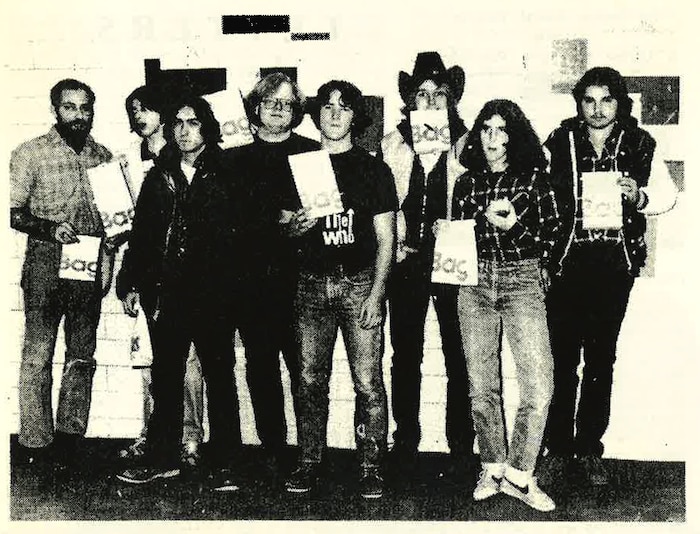
His pervasive presence made Seymour Glass synonymous with Bananafish, so when he relinquished his role as editor in Issue #8, the shift had to be explained. The task fell to Beezer, who opened his column with the lines, “Seymour Glass is dead. Long live death,” followed by a polemic decrying Glass’s lazy editing and ridiculous, pretentious, zany-hipster posturing. Glass told me that he stepped down when he moved out of town for a year to escape the tangled web of social relationships that festered among some of the Bananafish crew, a decision which would seem to have left Behr more or less in charge. According to the magazine, the head position went to a new recruit called Monica Monroe, a hardass from Adobe Books who Glass spoke about with a great deal of caution.
“Last I heard, she was in Minnesota teaching,” he said. But her absence didn’t seem to diminish the threat of her displeasure, so he described what seems like a contentious relationship very diplomatically: Monroe struggled to implement quality control and lucidity to the wacky process of constructing an issue of Bananafish. “[Monroe] was a lot more no-nonsense than I am,” he said. “I’m willing to put up with a fair amount of lunacy in order to get something I think is valuable. But she’s a lot harder to read.”
So “Miss Monroe,” as she was known in its pages, set out to temper the zine’s most rambunctious qualities and facilitate its production while Glass was away, which was a strikingly similar role to the one Behr played for the earliest issues, which suggests that Monroe might have been Behr’s alias. “If you imagine me working [on Bananafish copy], I’m sitting on my bed with a dictionary and a Chicago Manual Of Style with the printouts and marveling at the wacked-out people Seymour [and others] are interviewing or writing about – or irritated by some of the pretentious writers who contributed,” Behr wrote.
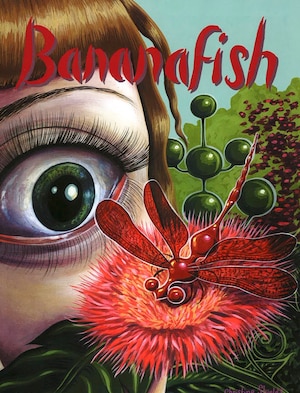
“Monroe was the editor, but I was still the face of the magazine,” Glass recounted. “Even when I wasn’t listed as the editor, everyone still treated me like I was – and I still acted like it. To be fair, it was probably very frustrating to be called the editor and then not get treated like it and to have this other guy who kind of is-but-isn’t the editor. I was the editor when it suited me, and when I didn’t feel like doing it, she had to.”
One of those shirked duties involved organizing the publication’s swelling ranks of contributors, which became more demanding when they started to use email to correspond. “Before, it was just people who knew each other locally, and we were all together in the same town doing the same things. But [after we started using email] some people were in Boston or Oregon – all over the place,” Glass said.
By Issue #12 in 1997, the magazine reached a tipping point – or maybe a zenith. The twelfth and thirteenth editions were the biggest in terms of the size of the magazine (100+ pages), its circulation (about 2,000) and its staff, many of whom Glass says were starting to get sick of Bananafish and one another. “The dynamic of the crowd of people that I knew in San Francisco was changing,” he explained. “People were moving, and it affected the magazine. Peoples’ relationships with each other had run their course. [Making it] was also getting more expensive to do because it was bigger and it had a color cover. So it was starting to feel like a thankless job.” As Beezer put it in Issue #13, “continuing to publish the magazine became as gratifying as playing in a volleyball league for people under four feet tall.”
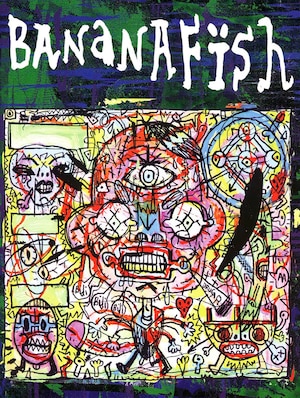
Issue #13 came out in August 1999, almost two years after its predecessor, with a reinvigorated staff and sense of purpose. “Visually, there was a great leap forward,” Glass said, describing the evolution of the magazine’s physical appearance. While early issues were printed in low resolution on 18 cm x 22 cm thick paper, the later ones were handled by different publishers and look more like a traditional commercial magazine, with larger, rectangular dimensions and glossy covers – although they were decorated with grotesquely psychedelic designs or photos.
But the troubles that caused Glass to step back from Issue #8 and nearly ended the magazine before #13 continued to plague Bananafish until its ultimate demise. The rewards that motivated contributors to work for free in the early ’90s – the sense of community among the staff and its readers, the feeling that they were contributing to the scene rather than just consuming the work of others, the enthusiastic response from fans and subjects – faded as readers’ attention shifted to digital media. And so the ever-increasing financial tolls and time commitments seemed less worthwhile.
“If you feel like writing is an obligation or a duty, it’s going to be there in the way you write, and to me it shouldn’t come across that way at all,” Glass said. “No one has to read it. No one has to care at all. So if you don’t really want to be doing it, why should anybody else?”
Producing a zine became an ever more absurd effort in the new millennium, and the qualities that made Bananafish a pleasure to read and write became untenable and unimportant in the digital paradigm. Printing physical copies of magazines and CDs limited its reach and made it expensive to make; its slow and unreliable production process defied the immediacy of digital content; its determination only to cover art its writers truly cared about limited its audience to likeminded fans; its refusal to explain those artists legibly to the uninitiated made it impenetrable to new readers. All of this made Bananafish totally unmarketable in a competitive field that based its value on measurable metrics of attention and maximum exposure. In 2016, Bananafish seems like a symbol of resistance to the market logics that rendered it effete and a tangible incarnation of what we has been lost in the transition to online music media.
“I think part of the reason it didn’t sell anymore is that the content isn’t something that anyone can just pick up and understand,” Glass said. “It’s like, ‘This is my world, and if you want to get into it, then you can, but if you can’t I’m not going to change the world so that you’d be more comfortable in it.’ I like something that’s confusing and I have to sit down and puzzle over it to try and figure it out.”
Bananafish’s merry prankster spirit made the magazine and the sources that document its history a puzzle to interpret and explain – if you care enough to jump through the hoops. Glass didn’t want to hand the keys to his secret world to the first reporter who asked for them, so it felt like he created trap doors and smoke-and-mirrors funhouses with phony timelines and fabricated anecdotes about meeting people who are probably just versions of him and his friends.
But I never called him out on a lie, even as their inaccuracies became increasingly obvious to me. His stories about Beezer didn’t add up or match with the timeline he gave me nor the information provided about him in the magazine; Glass didn’t even seem to recall or keep straight how old Vern was. Glass and I had a similar dynamic to the one described between Sybil and Glass in “A Perfect Day For A Bananafish”; I never confronted him with my very strong suspicions that Vern Beezer was his own alter ego and a device he deployed to represent the views of various staffers as needed to respond to criticisms from its readership, explain behind-the-scenes developments and generally compose an account of its own history. Instead, I asked him to tell me stories about meeting and knowing Beezer, and I believed them for a while.
After interviewing Glass and indulging his imaginations, I wrote to the email address listed on Adobe Books’ website asking for insight into the characters of Vern Beezer and Monica Monroe. The reply came within hours from Christine Shields, an illustrator and comic artist whose drawings appeared in many issues and who designed several Bananafish covers since 1992. “I was the manager of Adobe Books up until a few days ago,” she wrote. “I don’t know/can’t remember who Monica Monroe or Vern Beezer are…I’m sure they are pen names of people I might know.”
Despite her ambiguity, Shields’ mail debunked the myths of Bananafish to me. But I still didn’t want to tell Glass that I knew he was making a lot of it up. His apparent fantasies of encountering and then mourning such an implausibly enigmatic old man are more appealing than what mounting evidence has convinced me is the true story of Bananafish: Glass and his friends eventually outgrew the magazine. Their adolescent devotion to and attitude about confrontational music became untenable in both the increasingly commercial field of music media and in Glass’s impending new life as a father. But I still didn’t want to tell Glass that I knew he was making a lot of it up. I wanted the fantasy to continue, too.
Header image © Courtesy of S. Glass
